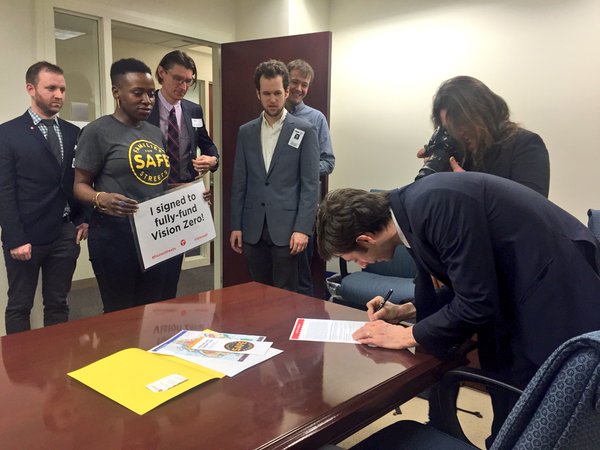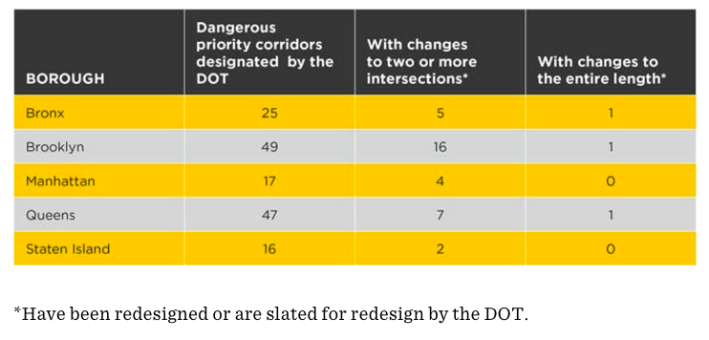
If the city hopes to dramatically decrease the number of traffic fatalities in New York City, DOT needs more resources to redesign the city’s most dangerous corridors and intersections.
That's the message 70 members of Transportation Alternatives brought to the City Council yesterday, meeting with 21 council members or their staff.
“We are calling on the council to increase funding and watchdog implementation of safety improvements along the priority corridors and intersections that the DOT has already identified in its Pedestrian Safety Action Plans,” TA Executive Director Paul Steely White said in a statement. “To increase staffing and pay for resurfacing, road marking, signaling, and outreach, the DOT will need an increase in the operating budget, not stagnation."

TA's Vision Zero Report Card, released in January, pointed to the slow pace of progress on the dangerous streets and intersections identified by DOT in its borough-by-borough pedestrian safety action plans. Only 22 percent of the 154 priority corridors have undergone safety improvements, and most of those improvements were to specific intersections. Only three of the 154 corridors have receive improvements along their entire length.
TA says DOT's annual budget for low-cost "operational" safety projects should be increased by $52.4 million, which it says would allow the department to complete 98 street improvement projects this year -- up from the department's official goal of 50 and the 76 it completed in 2015.
TA Deputy Director Caroline Samponaro told Streetsblog that DOT's action plans present a clear path to achieving the city's Vision Zero goals, but that DOT is not doing enough to implement those ideas. "[The action plans] are problem statements without any real timeline or standards of how they're going to address them all," Samponaro said. "The potential downside of all the great documents that exist and all the great rhetoric is that we're not following through on them. I think we still see the city tackling the easiest projects.
Samponaro emphasized the importance of growing DOT's operational budget. At his Vision Zero press conference in January, Mayor de Blasio focused on $115 million in new capital funds being dedicated to Vision Zero project, but those projects take years to build, while the quicker operational projects could have an immediate impact street safety. "There's an important cautionary tale with putting all the money in the capital budget," she said, pointing to "the power of plastic bollards and painting the street" to make streets safe.
This year, DOT expects to add 15 miles of protected bike lanes. TA members yesterday called on the city make that the new minimum standard, and for the council to provide "appropriate and necessary" funding to expand Citi Bike.
Thirteen council members signed on in support of TA's initiatives: Transportation Chair Ydanis Rodriguez, Majority Leader Jimmy Van Bramer and Council Members Karen Koslowitz, Carlos Menchaca, Costa Constanides, Daniel Garodnick, David Greenfield, Ben Kallos, Brad Lander, Stephen Levin, Mark Levine, Antonio Reynoso and Helen Rosenthal.
“It is certainly heartening that Vision Zero has brought about a reduction in fatalities and serious injuries. We cannot, however, take complete comfort in statistics because lives are still being lost,” Koslowitz said in a statement. “I urge the mayor to increase funding for the pedestrian safety action plans in order to expedite the completion of these plans.”





